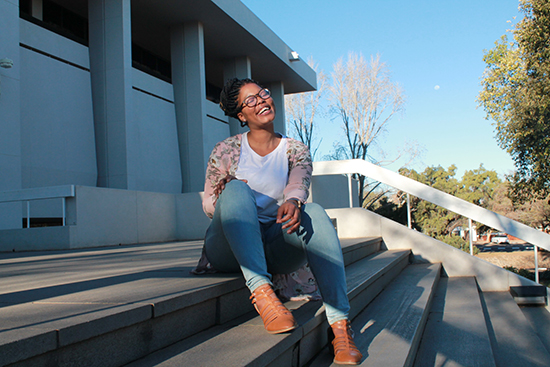Latest News Archive
Please select Category, Year, and then Month to display items
19 November 2018
|
Story Valentino Ndaba
|
Photo Xolisa Mnukwa
 “I’m an embodiment of the dreams of those whose lives have been marked by great struggles,and I want to propel and re-write the African child’s narrative.” - Priscilla Brandt
“I’m an embodiment of the dreams of those whose lives have been marked by great struggles,and I want to propel and re-write the African child’s narrative.” - Priscilla Brandt
Priscilla Brandt, first-generation LLB graduate, saw the opportunity to upgrade her career through the Graca Machel Trust, and grabbed the bull by its horns. Brandt pitched her skills and expertise to one of the trust CEO’s who happened to be part of a GLS panel discussion which was held on the University of the Free State (UFS) Bloemfontein Campus. Shortly afterwards, the organisation contacted her with an offer for a Legal and Governance research internship.
The Graca Machel Trust is an established Pan-African organisation that focuses on child health and nutrition, education, women’s economic and financial empowerment, leadership, and good governance. The trust functions under the leadership of Graca Machel, who is one of the world’s leading advocates for the rights of women and children and has stood as a social justice and political activist for years.
Brandt said her journey started in the township streets of Galeshewe, Kimberley, and was characterised by infinite difficulties and resolute challenges. However, her circumstances in no way deterred her from standing fervently in her trust and pursuit of a full and purpose-driven life.
According to Brandt, her university career involved working at several odd jobs concurrently in order to help take care of her family and to financially maintain herself throughout her varsity years. Despite her adverse circumstances, she managed to collect a vast array of domestic and international academic achievements.
She was the first female chairperson of the Black Lawyers Association Student Chapter at the UFS, served on the UFS F1 Leadership for Change programme, and represented the university in Japan. In addition to that, she formed part of a work and study-abroad programme in America for three months. She was a delegate to the International Youth Leadership Conference in the Czech Republic and was selected by the office of the Commonwealth Secretary General for the 33Sixty Conference in Singapore. Furthermore, she was nominated by the UK Humanitarian Affairs organisation to be part of the eighth University Scholars Leadership Symposium at the United Nations in Thailand.
Her knowledge and belief in her capabilities and work ethic drives Brandt to constantly challenge herself and strive for a life and character that embodies excellence.
Mathematical methods used to detect and classify breast cancer masses
2016-08-10
 Examples of Acho’s breast mass
Examples of Acho’s breast mass
segmentation identification
Breast cancer is the leading cause of female mortality in developing countries. According to the World Health Organization (WHO), the low survival rates in developing countries are mainly due to the lack of early detection and adequate diagnosis programs.
Seeing the picture more clearly
Susan Acho from the University of the Free State’s Department of Medical Physics, breast cancer research focuses on using mathematical methods to delineate and classify breast masses. Advancements in medical research have led to remarkable progress in breast cancer detection, however, according to Acho, the methods of diagnosis currently available commercially, lack a detailed finesse in accurately identifying the boundaries of breast mass lesions.
Inspiration drawn from pioneer
Drawing inspiration from the Mammography Computer Aided Diagnosis Development and Implementation (CAADI) project, which was the brainchild Prof William Rae, Head of the department of Medical Physics, Acho’s MMedSc thesis titled ‘Segmentation and Quantitative Characterisation of Breast Masses Imaged using Digital Mammography’ investigates classical segmentation algorithms, texture features and classification of breast masses in mammography. It is a rare research topic in South Africa.
Characterisation of breast masses, involves delineating and analysing the breast mass region on a mammogram in order to determine its shape, margin and texture composition. Computer-aided diagnosis (CAD) program detects the outline of the mass lesion, and uses this information together with its texture features to determine the clinical traits of the mass. CAD programs mark suspicious areas for second look or areas on a mammogram that the radiologist might have overlooked. It can act as an independent double reader of a mammogram in institutions where there is a shortage of trained mammogram readers.
Light at the end of the tunnel
Breast cancer is one of the most common malignancies among females in South Africa. “The challenge is being able to apply these mathematical methods in the medical field to help find solutions to specific medical problems, and that’s what I hope my research will do,” she says.
By using mathematics, physics and digital imaging to understand breast masses on mammograms, her research bridges the gap between these fields to provide algorithms which are applicable in medical image interpretation.